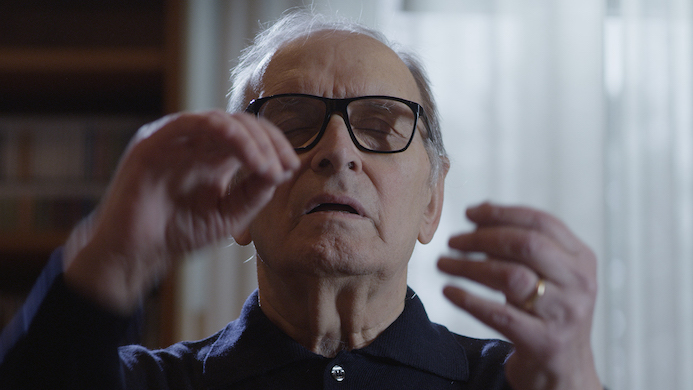Shady, Silly, or Classic: Composer Ennio Morricone Spread His Talents Far and Wide
In the MoMA series alone, there are films to which he contributed by directors who are high-minded, pulp-savvy, and genre-ready. Either Morricone had among the most catholic of tastes or he had no taste at all.

‘Ennio Morricone’
Museum of Modern Art
December 1-January 10
Looking at the list of films included in “Ennio Morricone,” a series beginning this Friday at the Museum of Modern Art, one can’t help but wonder if the eminent composer ever said “no” to a gig. Forget the number of movies and television programs to which Morricone contributed (rounding out, should you be curious, to an even 400), and instead, take into account their dizzying nature and quality.
At MoMA alone, there are films to which he contributed by directors who are high-minded (Lina Wertmüller, Mikhail Kalatozov, Roland Joffé), pulp-savvy (Don Siegel, Quentin Tarantino, Sergio Leone), and genre-ready (Mario Bava, Sergio Corbucci and Lucio Fulci). Either Morricone had among the most catholic of tastes or he had no taste at all. There’s also the distinct possibility that, you know, this artist believed in never turning down a paycheck.
Whatever the case, the run of films to be seen on 53rd Street — about three-dozen in total — testify to the breadth of Morricone’s accomplishment. No overview of this kind would be complete without “The Good, The Bad and The Ugly” (1966), the third in a series of films that have come to be known as “The Man With No Name Trilogy.” The first two, “A Fistful of Dollars” (1964) and “For a Few Dollars More” (1965), established a television actor by the name of Clint Eastwood as a viable commodity on the big screen. It was the success of “The Good, The Bad and The Ugly” that made him a star.
Morricone (1929-2020) wrote the score for all three films, but it was that distinctive run of notes in “The Good, The Bad and The Ugly” by which, according to MoMA, he “secured his place alongside Beethoven by composing one of the greatest opening themes in the history of Western music.” The main theme propelled the movie’s soundtrack to no. 4 on the Billboard charts. A subsequent cover by Hugo Montenegro and His Orchestra, with an ensemble of what sound like grunting cavemen, almost topped the charts, being prevented in doing so by Simon and Garfunkel’s “Mrs. Robinson.”

For movie-goers of a certain age, fans of cowboy flicks, and diehard cinephiles, the mere thought of the main theme to “The Good, The Bad and The Ugly” will likely prompt a pleasing shiver up the spine. Yet even the most benighted souls should recognize the whistling refrain and twanging guitar riff even if they don’t know its source.
Morricone’s song has become an inextricable component of our pop culture DNA, as indelible a musical touchstone as Bernard Herrmann’s shrieking string section from “Psycho” (1960) or the slowly ascending notes put into order by John Williams to herald Bruce the Shark’s arrival in “Jaws” (1975). How many people have “The Good, The Bad and The Ugly” as their ringtone? More than you could shake a Winchester 1866 at, I’m sure.
Born at Rome, Morricone was the son of a textile dealer and a professional trumpeter. Showing a gift for music early on, 12-year-old Ennio studied at the Saint Cecilia Conservatory, purportedly completing the school’s four-year program in six months. While writing his own compositions and music for the theater, Morricone worked in radio, headed a jazz band, started racking up hits, and began collaborating with a host of musicians who would come to include Paul Anka, Françoise Hardy, the Pet Shop Boys, Andrea Bocelli, K.D. Laing, and Morrissey.
It was Morricone’s partnership with a former schoolmate, Sergio Leone, that proved epochal. Working with tight budgets, Morricone did what he could for Leone’s grandiose conception of the American West by utilizing sound effects — the crack of a whip, say, or the howl of a coyote — as musical instruments. The Fender Stratocaster guitar proved integral to Morricone’s music, and his influence on Leone’s filmmaking was decisive. The reason the films were so slow, Morricone told the Guardian in 2007, was that Leone “kept the scenes longer simply because he didn’t want the music to end.”
The MoMA line-up is noteworthy, what with “The Battle of Algiers” (1965), “Two Mules for Sister Sara” (1970), “Investigation of a Citizen Above Suspicion” (1970), “The Thing” (1982), and “Cinema Paradiso” (1988) on the docket. Fare that some might have thought shady or silly didn’t hinder Morricone in the least. The press notes from MoMA commends the soundtrack to Fulci’s “A Lizard in a Woman’s Skin” (1971), a lurid tale of orgies and blackmail, as being “appropriately schizoid.” Did Morricone never give his all?
Let me put in my two cents for “Danger: Diabolik” (1968), a Pop-wise exploitation that took as much from James Bond and the “Batman” television series as did from the Italian comic of the same name. As helmed by Mario Bava, whose usual forte was horror, the film is more clever (and kitschy) than thrilling, but Morricone’s soundtrack is, you know, groovy.
Keyed to “Deep Deep Down,” a dreamy wash of sound with banshee-like vocals, the music clatters from free jazz to psychedelia to tinkly generic without a hint of strain. The man’s eclecticism is something to experience and will be on promiscuous display at “Ennio Morricone.”

